Dates for your Diary
Purple Plaque in honour of Thora Silverthorne
The unveiling will take place on Friday 13th May at 2pm
Coming soon – Platinum Jubilee Exhibition
Museum opening times
The Museum is open to the public, free of charge:
Thursday* to Saturday 10am – 1pm
April 100 Club
This month’s prize numbers were drawn by member Susan Davies and the lucky winners are:-
No. 42 Jude Bearcroft £20
No. 20 Gaynor Tucker £10
If you would like to join our 100 club and be in with a chance of winning, it costs just £1 a month. Ask at the museum for further details.
Café Prices
We are currently reviewing our café prices in light of the current cost of living crisis. If an increase is deemed necessary, we will endeavour to keep it as low as possible.
Condolences
It is my sad duty to report that Mrs Violet Owen, widow of the late councillor Ray Owen CBE, has passed away. It was only recently that she kindly entrusted her late husband’s Order of Chivalry medals to the museum and we would like to extend our condolences to her family and friends. The awards, which comprise the CBE, OBE and a key given to Councillor Owen for opening Blackwood ambulance station, are available to view in our ‘New Acquisitions’ cabinet near the entrance.

Above, CBE front left with OBE and key above & photograph of Violet with husband Ray
New Railway display
Have you noticed our new railway display? The train track and model trains belonged to the late John Layton and were left to us in the gentleman’s Will along with several other items. We found the perfect spot for it and our deputy curator, Gareth Murphy, and volunteer Colin Ewers have spent many hours (and many attempts) creating a case to protect the exhibit using the perspex purchased for Covid screening. Take a look on your next visit.
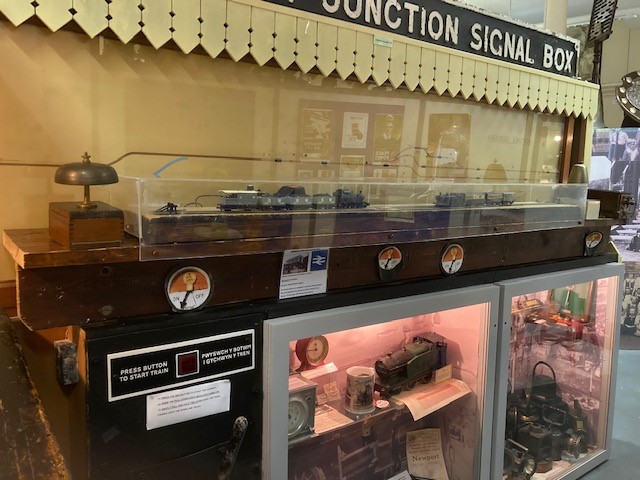
EPCOT
Experimental Prototype Community Of Tomorrow
That was the original concept of Walt Disney, who following his successful venture into theme parks in the 1950s with Disneyland California, wanted to follow that up with an experimental futuristic city to include a city centre, residential areas, schools and industrial sites with a revolutionary transport system to move people about the city leaving the streets a pedestrian zone. To this end Walt bought up vast swathes of Florida swampland. Sadly, a heavy smoker all his life, Walt died in December 1966 aged just 65 and, without Walt, his concept of this city was abandoned. Instead the company, under the direction of Walt’s older brother Roy, set about using the Florida land bought by his brother to open a theme park. The Magic Kingdom opened to the public in 1971 and Disney World* was born with the section Tomorrow Land with its train ride ‘The People Mover’ (where you will pass by a model of a city), as a nod to Walt’s vision of EPCOT. (*There are many ‘Disneylands’ around the globe but only one Disney World).
The company then turned its attention to creating a nearby sister park incorporating some of Walt’s original concept of the ‘experimental community’. Initially the designers were unable to agree on the concept. Some wanted it to be a glimpse into a utopian ‘Future World’ showcasing the latest technology while others wanted it to be a window into cultures and customs. Eventually they agreed to combine the two and EPCOT was born though the acronym was dropped and it became just ‘Epcot’.
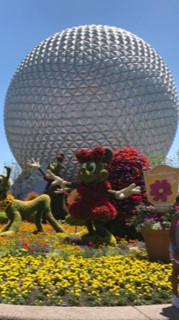 The park, twice the size of The Magic Kingdom, opened almost forty years ago on 1st October 1982 and is characterised by the epic huge ‘golf ball’, otherwise known as Spaceship Earth, that greets visitors on arrival. Enter the ball, board a car, and you are transported on an educational tour through the history of communication.
The park, twice the size of The Magic Kingdom, opened almost forty years ago on 1st October 1982 and is characterised by the epic huge ‘golf ball’, otherwise known as Spaceship Earth, that greets visitors on arrival. Enter the ball, board a car, and you are transported on an educational tour through the history of communication.
Initially there were just two sections to the park, Future World and World Showcase. ‘Future World’ today though has been subdivided into three sections comprising World Celebration, World Nature and World Discovery. Here you will find attractions such as Soaring, a simulated hang-glider ride over many of the Earth’s wonders including the Great Wall of China and the spectacular Brazilian Iguazu Falls while Test Track, allows you to become a Formula One test driver. Mission Space allows you to become an astronaut in a very realistic simulated rocket launch to Mars; a ride not for the faint-hearted and the only ride where I have ever seen sick bags provided!
But Epcot is probably best known for its ‘World Showcase’ which can be found on the far side of the lake around which Epcot is built. It stretches for 1.2 miles and is a look at the culture, architecture and food of different countries. Originally featuring 9 countries; USA, UK, France, China, Mexico, Germany, Italy, Canada and Japan, it was later expanded to include Norway and Morocco and there is still room for a further 6 countries to be added in the future.
Each ‘country’, or pavilion as it is called, is instantly recognisable by its architecture and iconic buildings such as the 103 foot Eiffel Tower in ‘France’ which is cleverly positioned to give the optical illusion of being full scale. Three of the pavilions even have ride attractions within them, the latest of which is ‘Ratatouille’ in the French quarter. Call me biased but my favourite pavilion has to be the UK’s which is a piece of ‘Old Blighty’ right in the heart of Florida. Here you can wander around a quaint ‘English’ village with red phone and post box, a scaled down Hampton Court Palace (see photo below) complete with hedge maze at the rear and shops where you can buy authentic souvenirs such as English tea. Here too you can eat pub grub in the ‘Rose & Crown’ washed down by real ale or pop next door to the Yorkshire Fish ‘n’ Chip shop for a fish supper and a ‘proper’ cup of tea and all manned by Britons, (maybe the only place in Florida where you can ask for ‘chips’ and not be given crisps!).

Visit Epcot in the spring and enjoy the International Flower & Garden Festival, while in the autumn you can enjoy the International Food & Wine Festival. Epcot has so much to offer that to call it a theme park really doesn’t do it justice and while Walt Disney’s dream city never materialised, his transport system did. Once at Disney World, be it at one of the many resort hotels, any of the theme parks, or even Disney Springs, transport around the 40 square mile site is then completely free and varies widely from buses, to monorails, to boats and the latest, cable car. To see more photos of Epcot visit our Facebook page.
Sally Murphy
ABERTILLERY PARK
We all have our own memories of Abertillery Park. As a child I remember using the play area, the tennis courts and swimming in the freezing cold open air baths. It was where the circus set up camp and I have in my mind that other events also took place there. I distinctly remember that in those days the River Ebbw which flowed through the park was black and smelly, quite a contrast to the formal beds of colourful flowers. The park still has a fine bowling green, rugby pitch and an open playing field area. It is a real asset to the town though sadly all too often subject to vandalism. But how did Abertillery end up with such a fine park? Here is the story…

It started in September 1889 when, against a picture of a growing town and the establishment of a number of successful sports clubs, the Chamber of Trade decided to approach the Abertillery Local Board to discuss the provision of a recreational ground and bandstand. The land at the end of Glandwr Street was a favourite from the start but the owners – Webbs Brothers – were not interested in selling. Meantime, more and more clubs expressed an interest in having space to play and train so the interested groups now included cricket, football, rugby, cycling and tennis as well as an acceptance of the need for an area where children could play safely. However, it was not until 31st January 1898 that Abertillery District Council announced that the land had been acquired and work could start. No time was then lost and a start was made on acquiring wrought iron benches, providing paths and planting trees, and this work was followed by earthworks and the provision of play equipment. The park was formally given the name of 'The Abertillery Recreation Grounds' and rules were set out as to when music might be allowed, the prohibition of many sporting activities on Sundays, and a requirement that additional sports such as hockey only be allowed if they had a specific area of land and paid for its use.
The park had an ornamental pond and a bandstand was erected near it. The park went from strength to strength, hosting shows such as the Bedwellty Agricultural Show and sporting events; its success was such that negotiations were soon under way to extend the park.
The next major milestone was the decision in 1906 to erect a grandstand (with construction work paid for by the football club), followed by proposals for tennis courts and a bowling green. There followed some reconstruction work and replanting of the park and in June 1914 the grandstand (already built for some time) was formally opened along with the reorganised park. Meantime, in 1912, Tredegar District Council had given Abertillery some peacocks and peahens to grace the park and a Mr Parfitt donated some pigeons for the aviary.
There were certainly no peacocks or an aviary when I used the park in the fifties and early sixties but it was clearly shaping up into the park I knew; the powers-that-be introduced a cricket pavilion (1920), terraces (1921), new tennis courts (1922), renovated bowling green (1927) and floodlights. (1932). There were proposals for a boating lake but they never came to fruition and as time went by the lower part of the park and its formal flower beds fell into disrepair; part of this land was sold off for a Remploy factory (now demolished). Sadly, the picture of neglect is all too apparent in these days of austerity and the rise of leisure centres and gyms has perhaps put public parks on the sidelines but they are still a wonderful asset – a green lung where you can enjoy the open air for free and still a good place to take your children and grandchildren if only for space for them to let off steam.
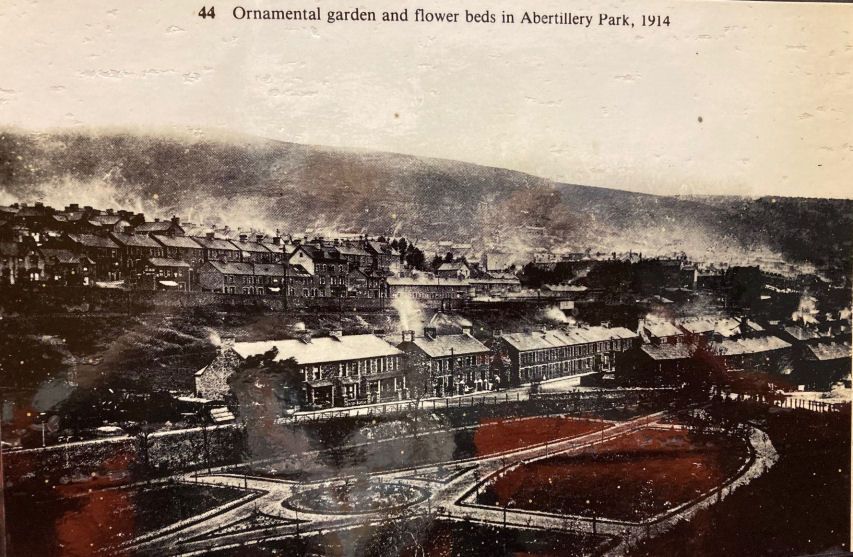
I am indebted to Graham Bennett for kindly allowing me to use his article as the source material for this short piece. The article can be read in full on Graham's wonderful website – it is full of articles on just about every possible subject of local and wider historical interest and is well worth exploring. The site also contains an article on swimming baths in Abertillery, including the open-air baths which are so clearly etched in my memory on account of that cold mountain water which fed them.
Jen Price
Branston Pickle
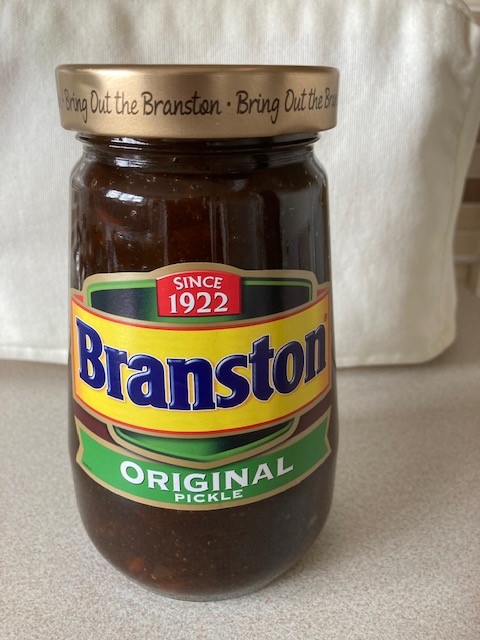 I have an allotment and because I invariably have more than enough fruit and vegetables I make several jars of chutney each year. That means I don't buy Branston pickle these days, but I used to – nothing like a cheese and pickle sandwich. I think we have all eaten it, all recognise the label, all think of Branstons if we think of pickle. It really is one of those household names like Marmite or Worcester Sauce.
I have an allotment and because I invariably have more than enough fruit and vegetables I make several jars of chutney each year. That means I don't buy Branston pickle these days, but I used to – nothing like a cheese and pickle sandwich. I think we have all eaten it, all recognise the label, all think of Branstons if we think of pickle. It really is one of those household names like Marmite or Worcester Sauce.
Did you know that Branston Pickle is 100 years old this year? Or that was named after the Staffordshire village of Branston near Burton on Trent where it was made by Crosse & Blackwell.
And how much of it do you think we eat? According to Wikipedia, we eat over 17 million jars of Branston pickle each year – that's an awful lot of pickle! This sweet but spicy product is made with diced vegetables including swede, onions, cauliflower, marrow, gherkins, chopped dates and carrots, cooked in a sauce of sugar, salt, vinegar, garlic, tomatoes and apples along with some spices. Exactly which spices are used remains a closely guarded secret but the list is believed to include mustard, pepper, nutmeg, coriander, cinnamon, cayenne and cloves.
According to the internet, Crosse & Blackwell bought the recipe for the pickle from a Mrs Caroline Graham and her two daughters who lived at Branston Lodge in Branston village. In readiness for mass production, the firm bought a large brick factory building which had originally been built to make machine guns for the First World War and which the government was selling off. The company also, as was not untypical of the time, bought a large house in the village intended to house single women who would be employed at the pickle factory and built about 30 family houses for workers. Despite, or perhaps because of, this heavy investment, just a couple of years later production moved to London and subsequently to several other locations. It is now made in Bury St Edmunds in Suffolk by Mizcan Euro, a firm of vinegar specialists to whom it was sold in 2013, but using the same basic secret recipe.
If you are a Branston pickle fan you are obviously not alone given the annual sales but apparently Keith Richards of the Rolling Stones always takes Branston pickle on tour and in 2002 England's World Cup Squad asked for a crate of Branston pickle to be delivered to their training camp in Japan. The England team did well and won many of their matches but were eventually beaten by Brazil who went on to win the tournament.
Just to finish, how do you like to eat your pickle? Although I don't buy Branston’s these days, my favourite way of eating chutney is still in a cheese sandwich, or a cheese and chutney toastie, mmmmm......
Jen Price
Mystery Tapestry Update
 Following on from last month, and thanks to some clever sleuthing by two of our volunteers, we now know more about the mystery tapestry. The underside of the tapestry, until recently unknown to us, with the name C Hedditch, front and centre, was done to mark an event; that event being the Battle of Heligoland Bight on 24th August 1914. It was the first Anglo-German naval battle of the war and involved the HMS New Zealand. The ship had been funded by, not surprisingly, New Zealand as a gift to the British Government and was commissioned into the Royal Navy in 1912. On board that ship during the Battle of the Bight was none other than one Charles Hedditch. Charles, who was born in Somerset in 1889, moved to Abertilley at some point after leaving the navy as records show that he and his wife Mabel, were living in Bournville Road, Abertillery by 1939. Records also show he was working at one of the local coal mines and it was probably that which drew him to Abertillery. We have also discovered that we have four World War I medals belonging to Charles Hedditch on display.
Following on from last month, and thanks to some clever sleuthing by two of our volunteers, we now know more about the mystery tapestry. The underside of the tapestry, until recently unknown to us, with the name C Hedditch, front and centre, was done to mark an event; that event being the Battle of Heligoland Bight on 24th August 1914. It was the first Anglo-German naval battle of the war and involved the HMS New Zealand. The ship had been funded by, not surprisingly, New Zealand as a gift to the British Government and was commissioned into the Royal Navy in 1912. On board that ship during the Battle of the Bight was none other than one Charles Hedditch. Charles, who was born in Somerset in 1889, moved to Abertilley at some point after leaving the navy as records show that he and his wife Mabel, were living in Bournville Road, Abertillery by 1939. Records also show he was working at one of the local coal mines and it was probably that which drew him to Abertillery. We have also discovered that we have four World War I medals belonging to Charles Hedditch on display.
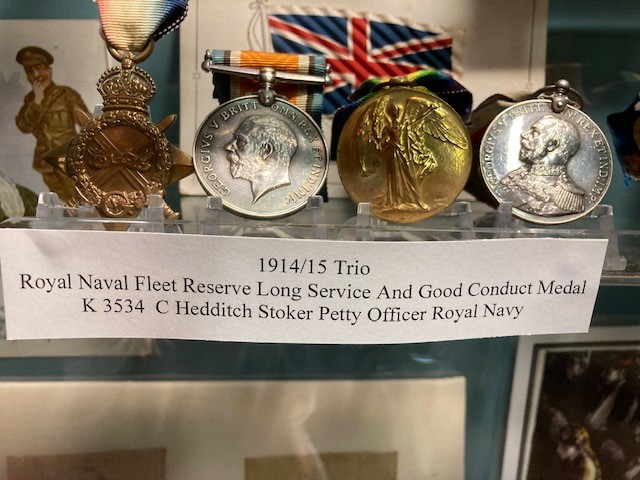
Top Of Page
